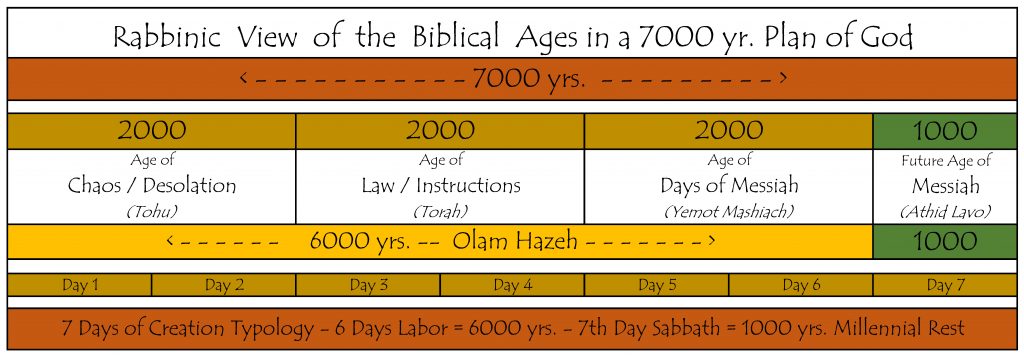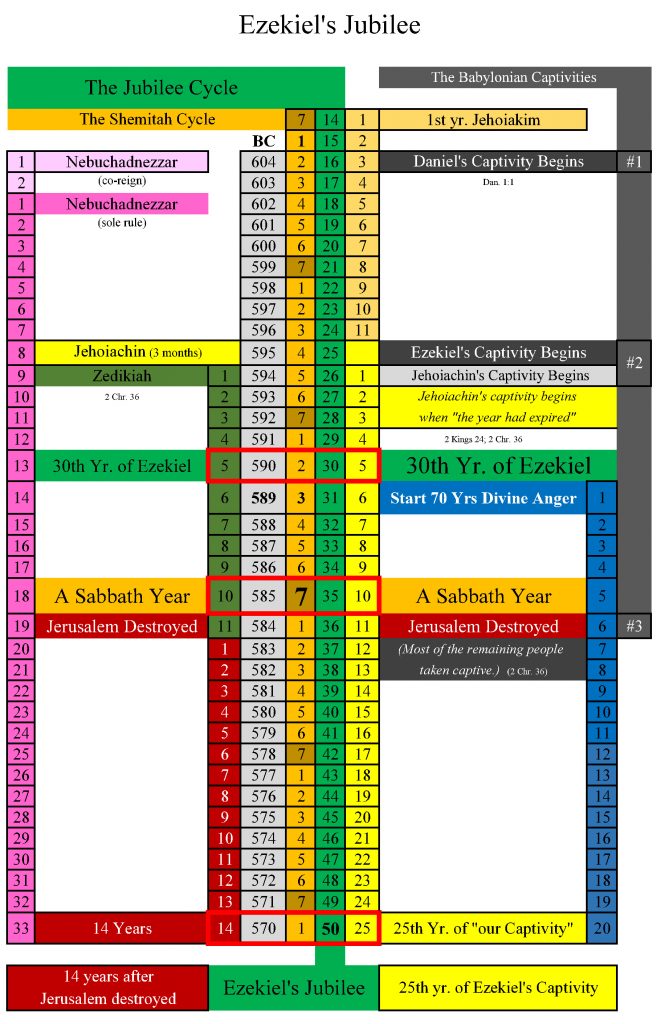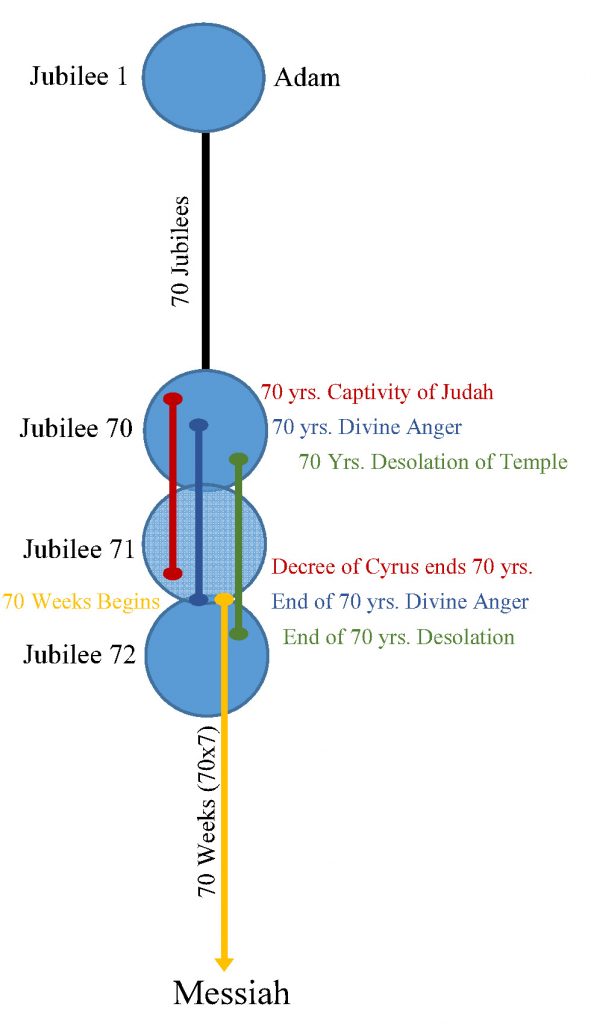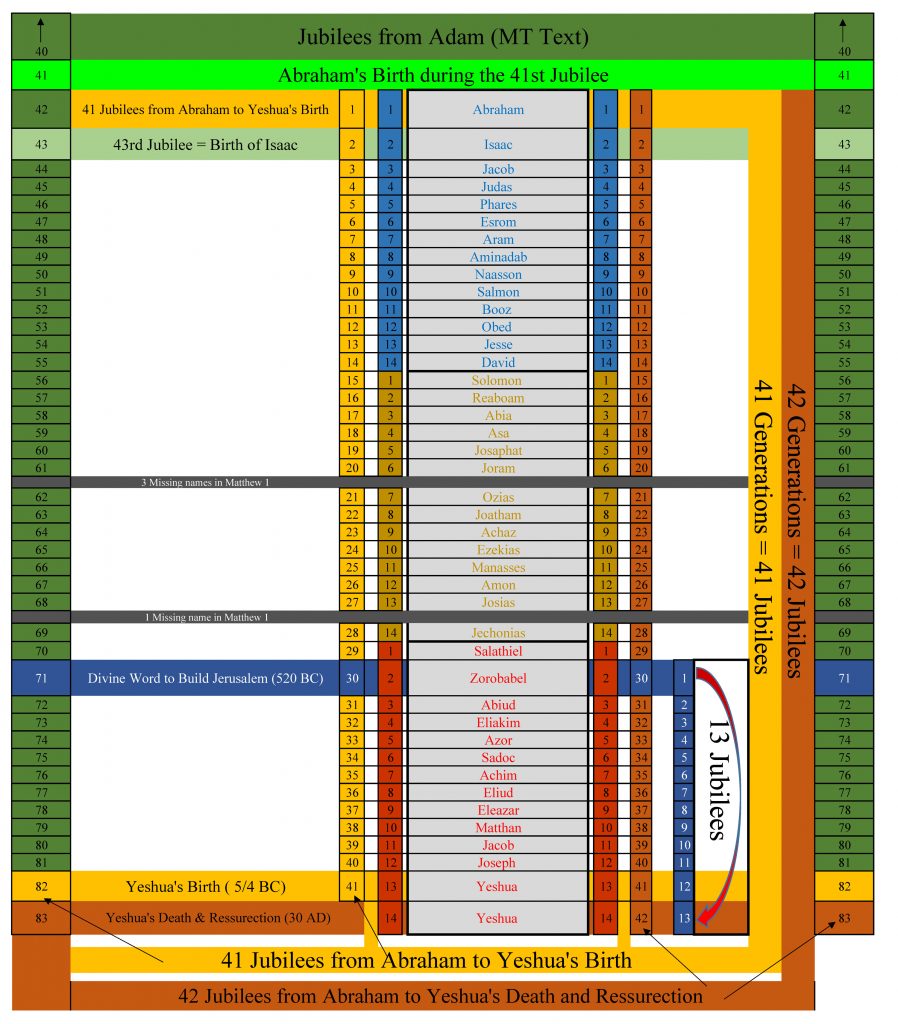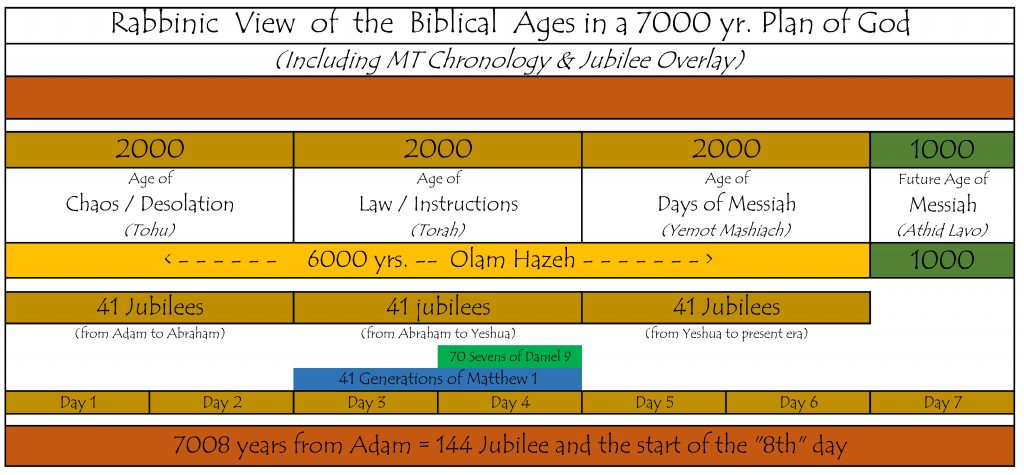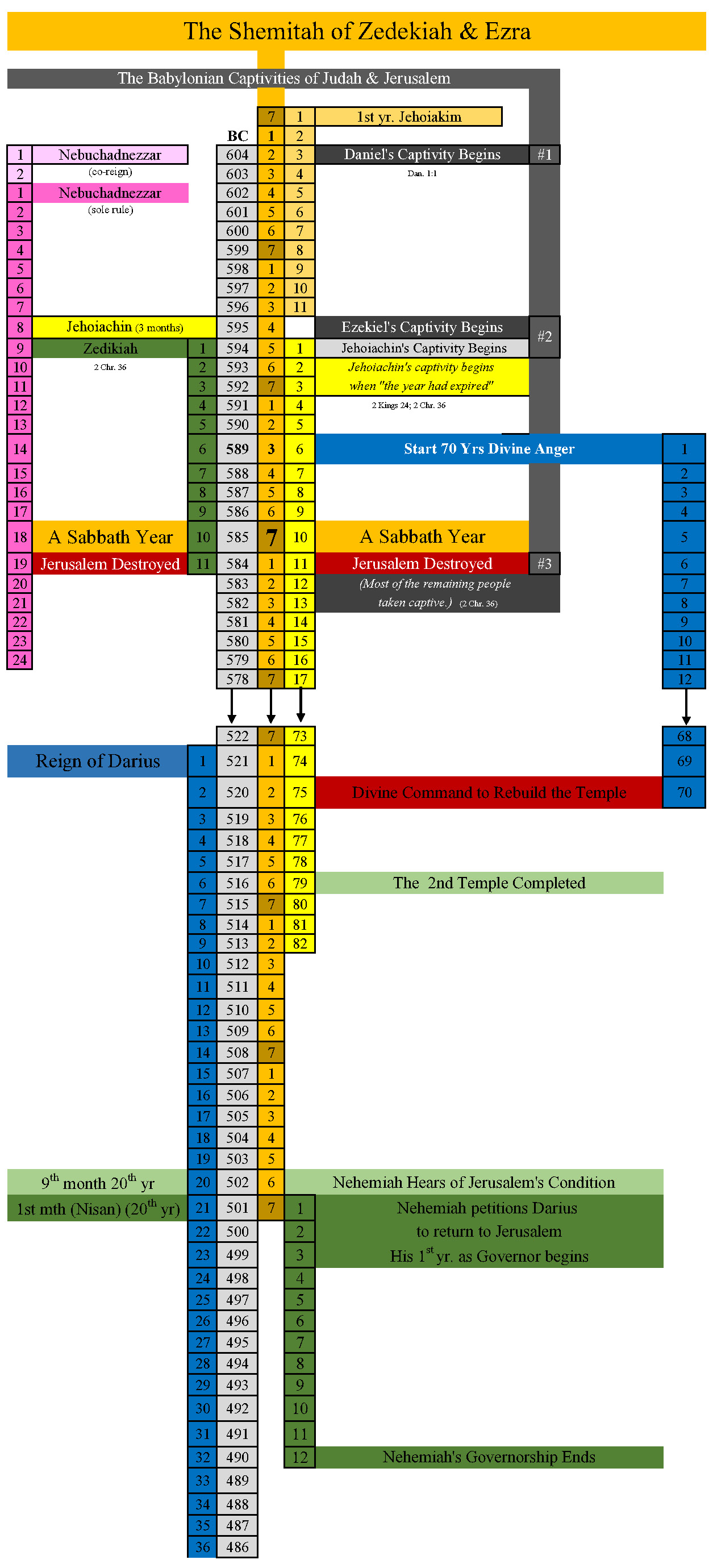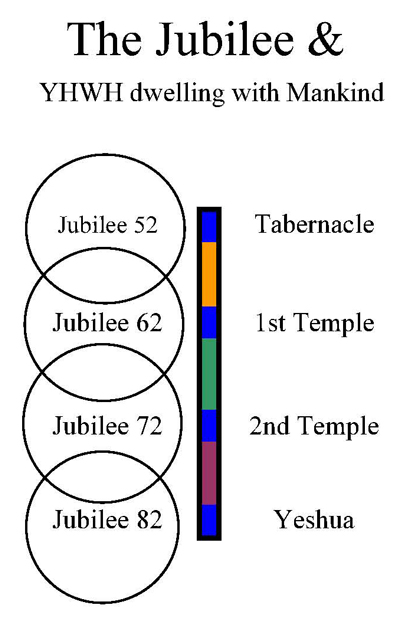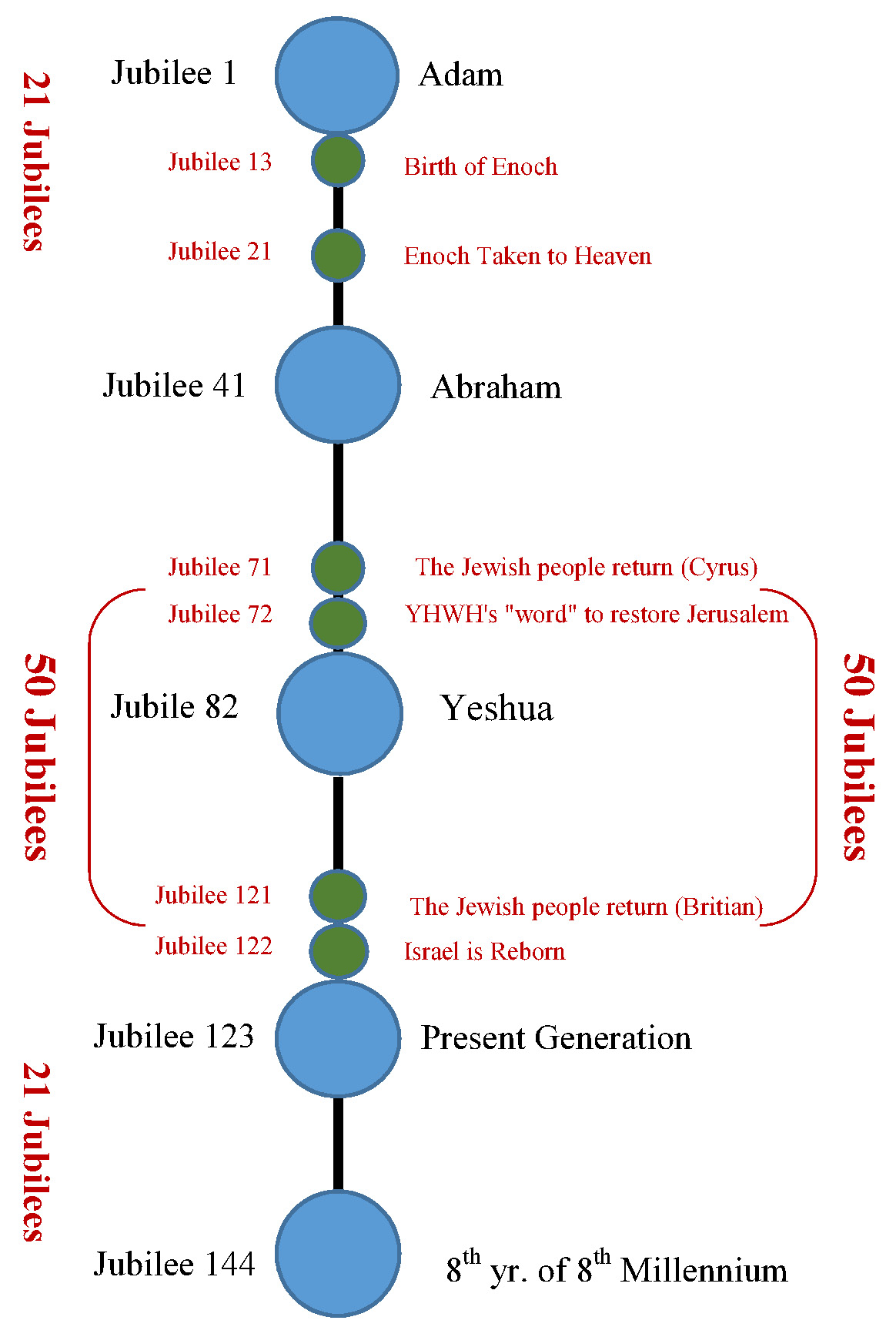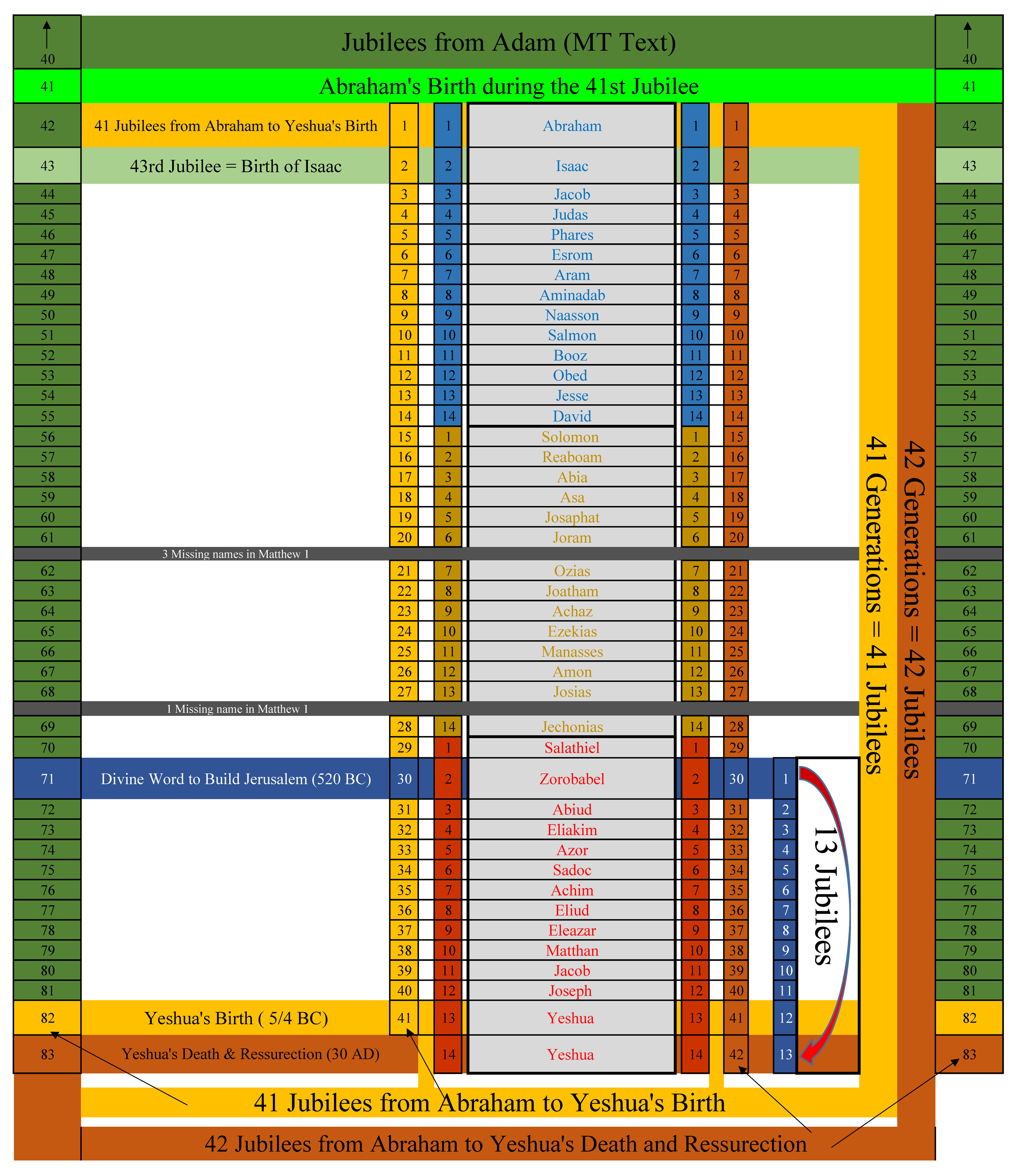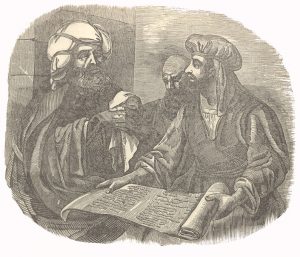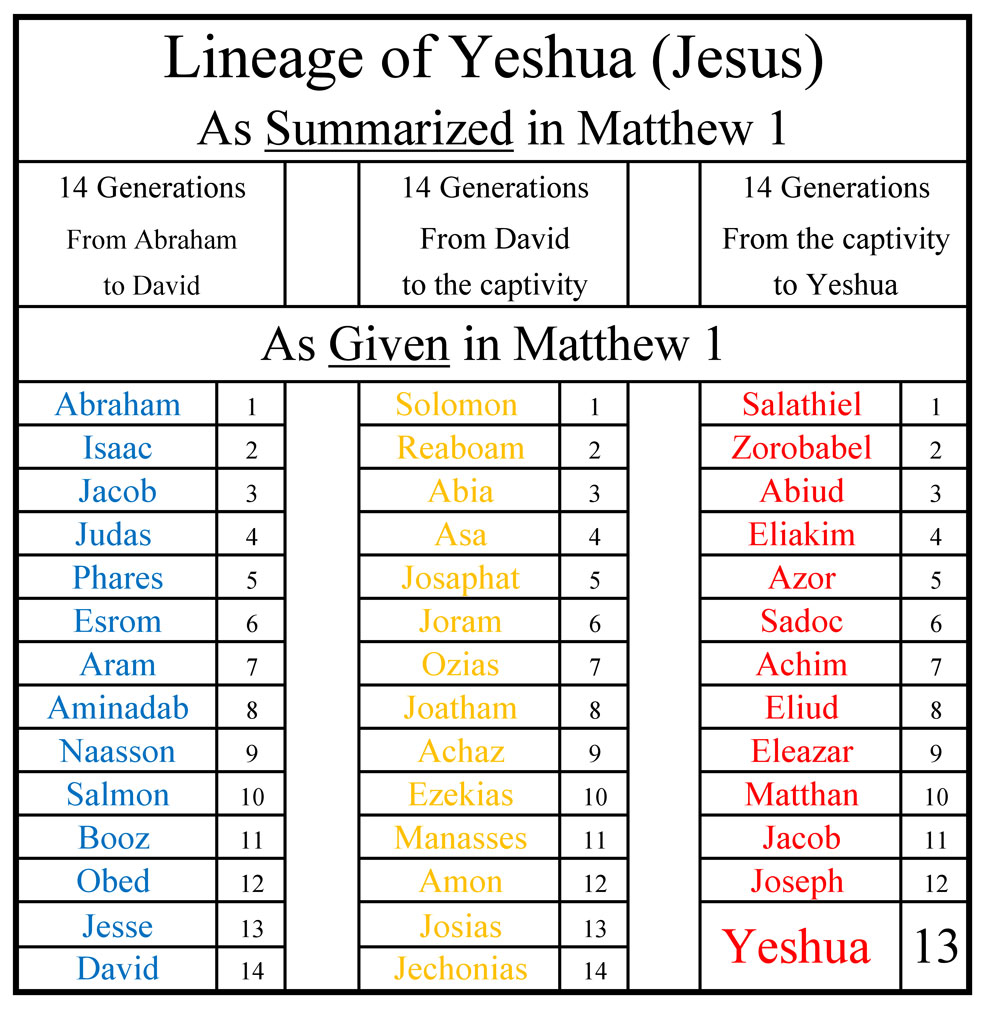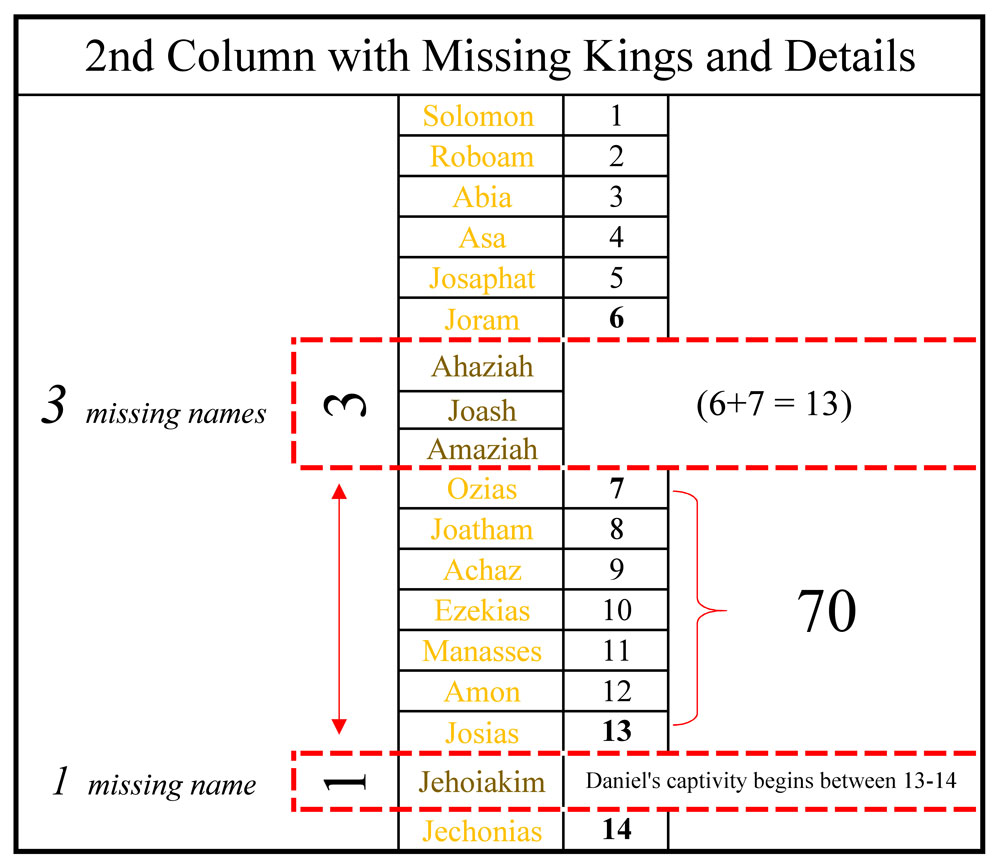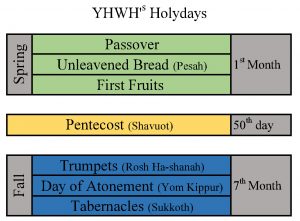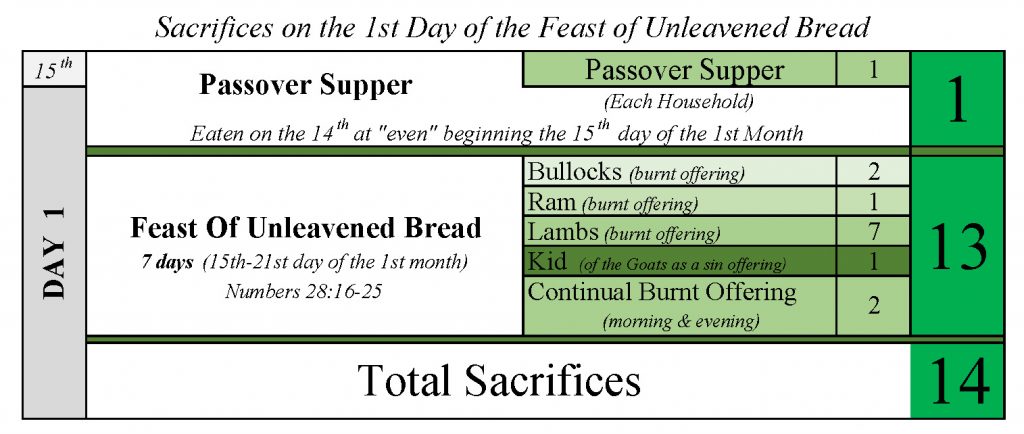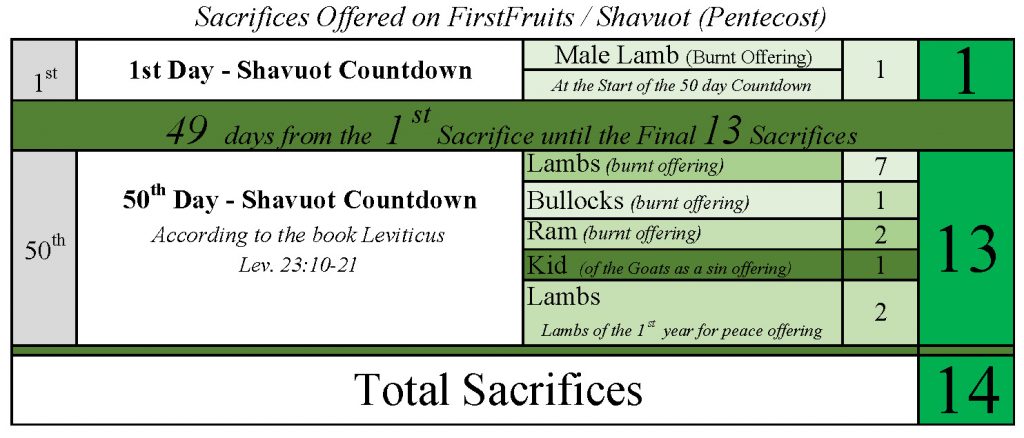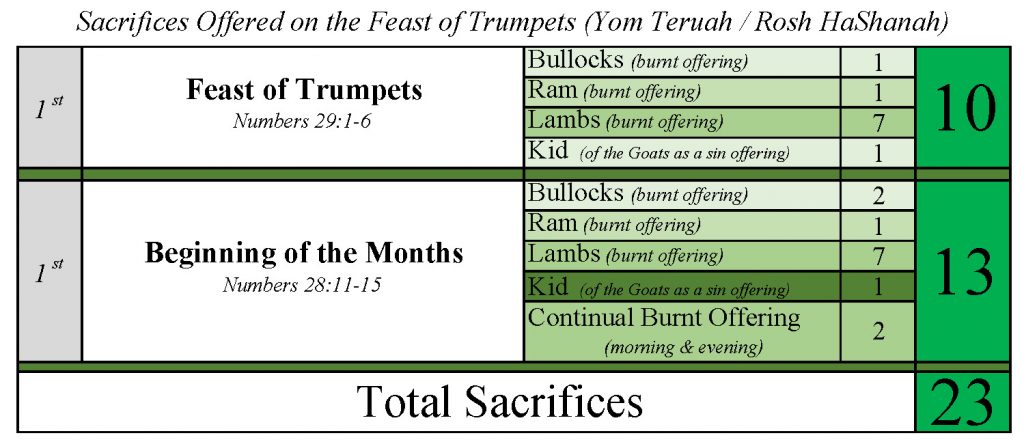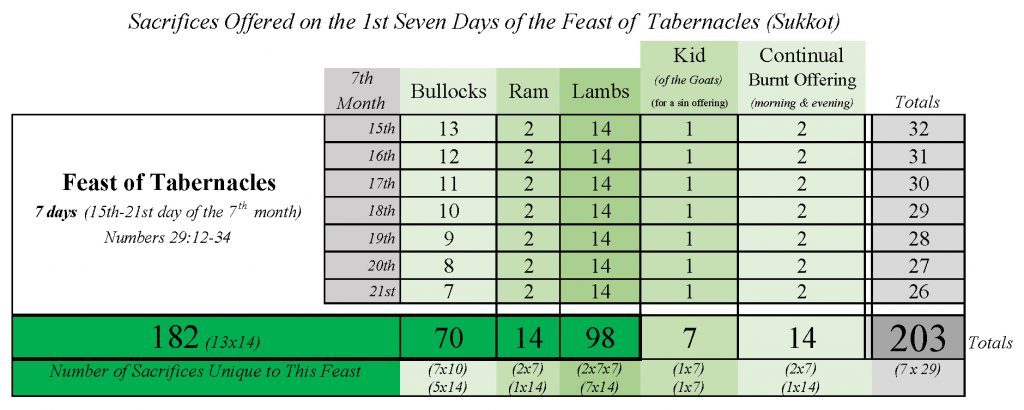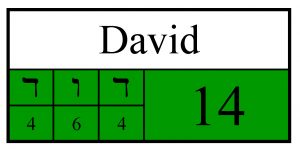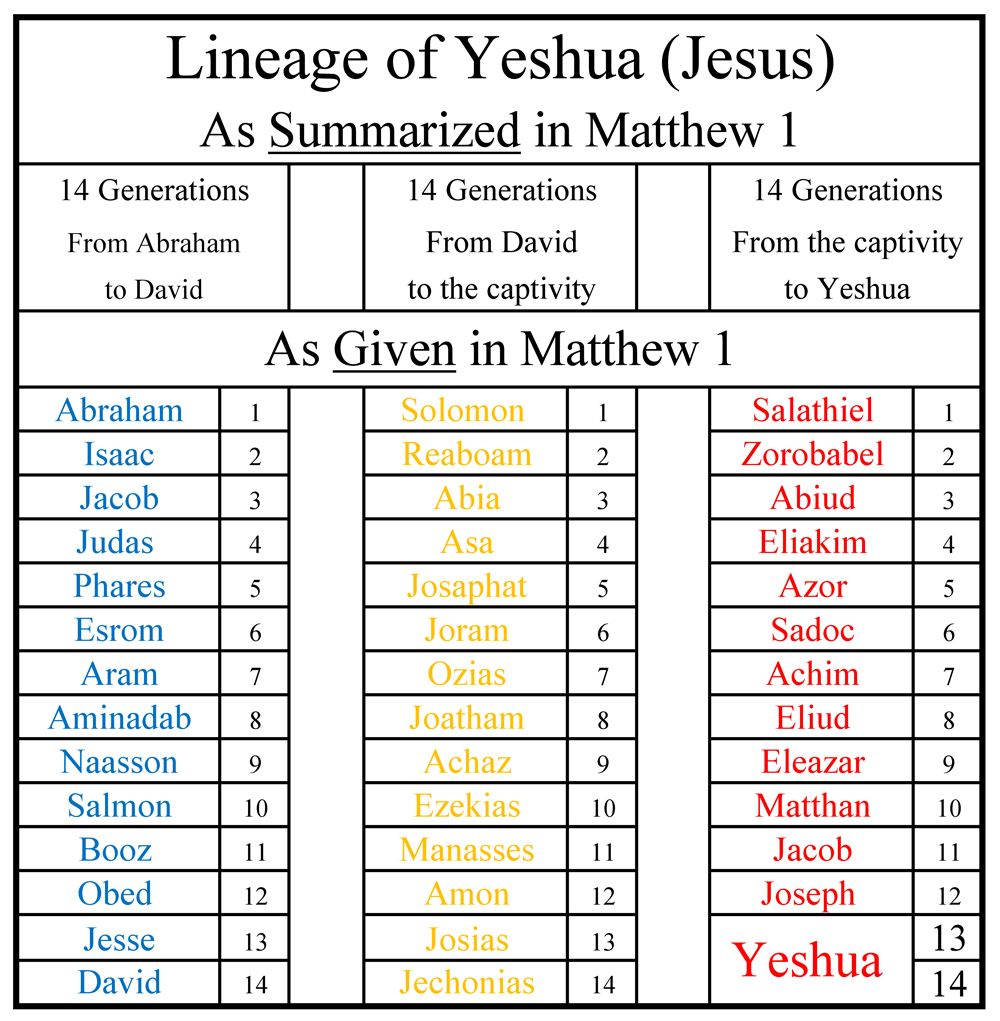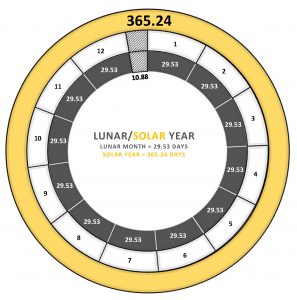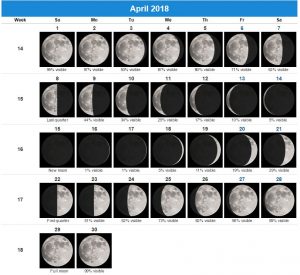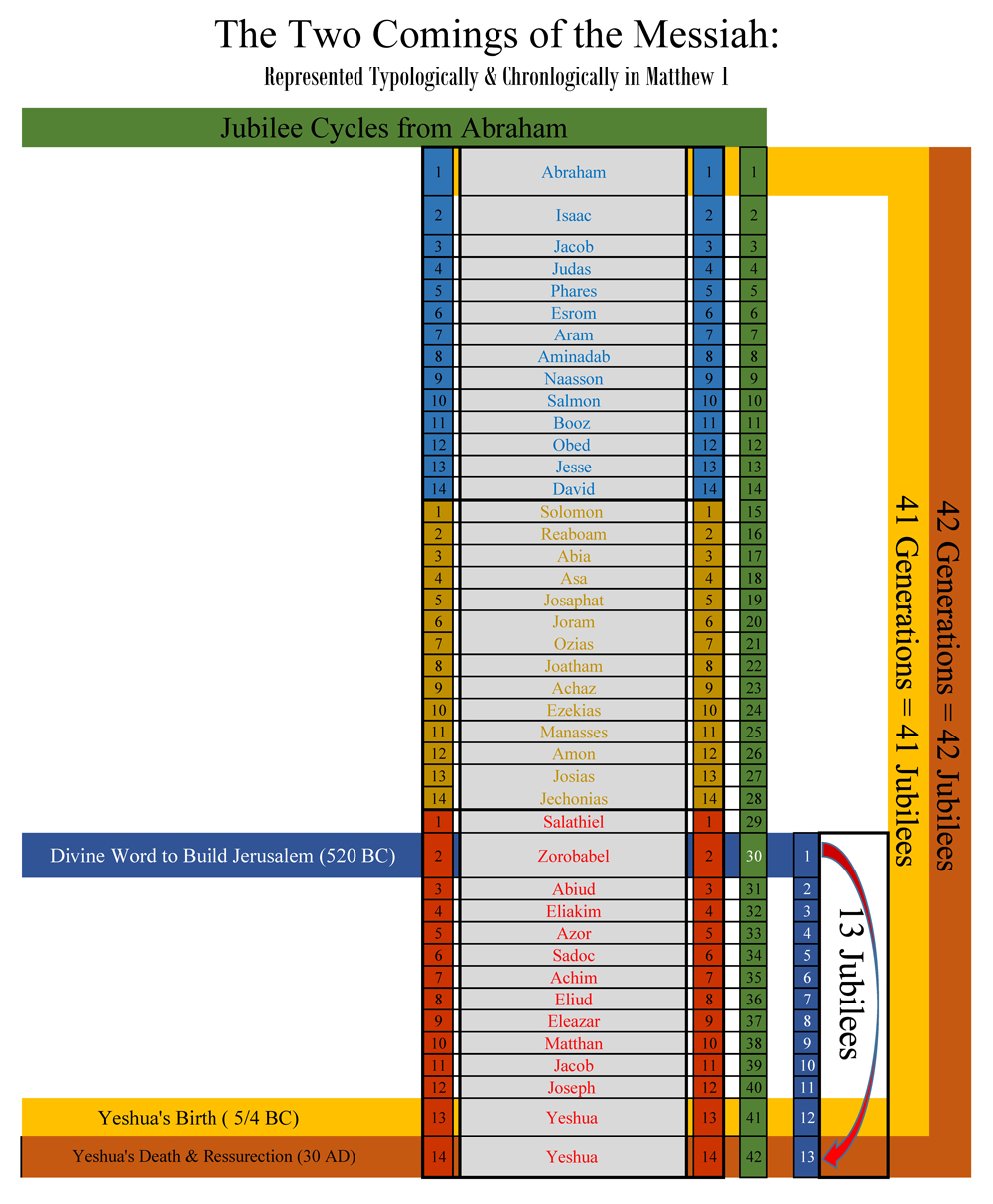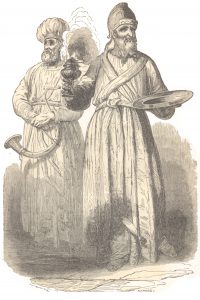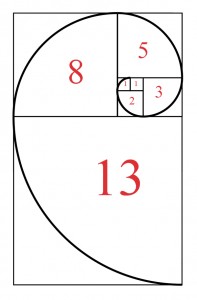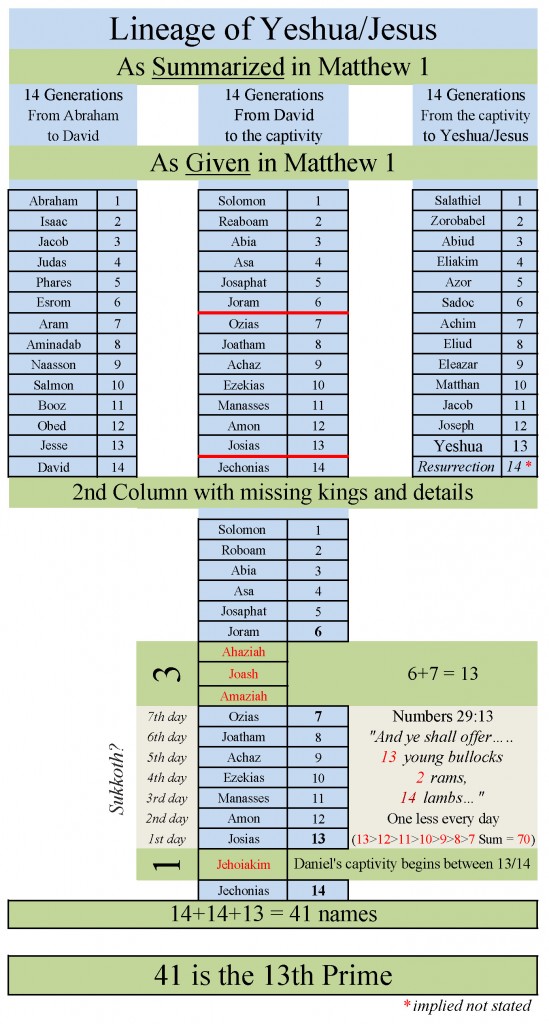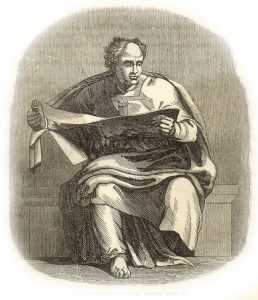 Authors Note:
Authors Note:
This article is Part III in my exploration of Rabbinic forgery hypothesis. The following links will take you to the previous articles in this series.
Part I: The Septuagint, the Masoretic Text, & Matthew 1
Part II: Matthew 1, the Masoretic Text, & the Bible’s Messianic Symbolism
Part III: The Masoretic Text, Matthew 1, & the Jubilee
Part IV: Sir Isaac Newton, Daniel 9, & the Rabbinic Forgeries Hypothesis
So did the Rabbinic Jewish scholars of the 2nd century AD forge the Masoretic text to obfuscate the Biblical chronological evidence that proves Yeshua (Jesus) was the Messiah promised in the Scriptures? Remember this is the underlying premise of Rabbinic forgery’s hypothesis that contends the Masoretic text is not a reliable template of Old Testament chronological history.
To ensure we don’t lose sight of the underlying thread of the forgery’s hypothesis, here once again are excerpts from Mr. Sexton and Mr. Smith’s papers on the subject:
The evidence suggests that the chronology in the MT did not exist before the second century of the Christian era. Russell concludes that “in the days of Josephus, as well as in those of the annalists who preceded him as compilers from the Jewish Scriptures, there was no difference in the numerical statements of the Greek version, as compared with the text of the original Hebrew.”128 ( Who Was Born When Enosh Was 90
Since Jubilees was immensely popular in Second Temple Judaism, I theorize that the rabbis were aware of this construct in Jubilees and adapted the concept into their Hebrew manuscripts of Genesis 5 to reduce the pre-Flood chronology by 600 years in order to discredit Jesus as the Messiah. (From Adam to Abraham: An Updated on the Genesis 5 and 11 Research Project: Dec. 16, 2017)
Before digging into the Jubilee aspect of this subject, I think it’s important to emphasize how many of the Jews and Christians of the 1st century understood a past, present, and future panoramic view of Biblical history.
It may surprise some of you to learn that the millennialist view of Biblical history (6000 years of mankind’s labor under the curse of sin with a coming literal 1000 year reign/rest of Yeshua) was the predominant view of the early Christian church up until the time of the church father Origin. But this view wasn’t just limited to the early church of the first few centuries. In fact, Rabbinic traditions complied in the Talmud (100-500 AD) also held the millennialist perspective of Biblical history.
This needs to be repeated – up until the 2nd century Christian and Jewish traditions shared a common eschatological understanding of the Biblical ages. A majority of both believed the messianic age was a literal and future 1000 year reign of the Messiah upon this earth.
The Septuagint version of the Bible’s chronology placed this future millennial age only 500 years into the future (from the birth of Yeshua). The Masoretic text on the other hand placed the millennial age nearly 2000 years from the birth of Christ.
What’s odd to me about the Rabbinic forgery’s hypothesis is that it seems incongruent with what the Jewish traditions actually taught about the Messianic age. You see, as evidenced by the Talmud, Biblical history was divided into three – 2000 year ages followed by the 1000 year reign of the Messiah. This view was based in the 6 days labor & 1 day rest of creation. The chart below reflects these Talmudic traditions:
As you can see Biblical history of the present age (Olam Hazeh) was divided into three 2000 year periods. Notice the third period from 4000-6000 (from Adam) was considered the age of the Messiah. I quote from the Talmud:
There is a Boraitha in accordance with R. Ktina: As in the Sabbatic period, the seventh year is a release, so will it be with the whole world that one thousand years after six will be a release, as above cited verse [Isa. xii. i] and [Ps. xcii. 11]: “A Psalm or song for the Sabbath day,” which means the day which will be all Sabbath. And as [ibid. xc. 4]: “For a thousand years are in thy eyes but as the yesterday when it is passed.”
The disciples of Elijah taught: The world will continue for six thousand years, the first two thousand of which were a chaos (Tahu), the second two thousand were of wisdom, and the third two thousand are the days of the Messiah, and because of our sins many, many years of these have elapsed, and still he has not come.
Elijah said to R. Jehudah, the brother of R. Sala the Pious: The world will continue for no less than eighty-five jubilaic periods, and in the last jubilaic period ben David will come. (anonymous. The Babylonian Talmud (Annotated) (p. 317). Unknown. Kindle Edition.)
Now think about the challenge this poses to the Rabbinic forgery’s hypothesis. The chronology of the Masoretic text (which was supposedly forged) places the birth of Christ about the year 4000 from Adam right at the start of the “Days of the Messiah”. If the Jewish Rabbinic authority had really forged the chronology of the MT text of the Scriptures to disprove that Yeshua was the Messiah, why then would they have changed the chronology of the Old Testament to show that Yeshua’s birth began those “Days of the Messiah”. Certainly a 5500 year birth date for Yeshua (as described by the LXX), towards the later end of the “Days of the Messiah” would have been less auspicious.
But let’s look back at history. Doesn’t the MT text of the Scripture accurately reflect the Messianic significance of Yeshua’s birth, death, resurrection, and the gospel age as seen through the lens of the Rabbinic tradition and the New Testament accounts?
Wouldn’t the past 2000 years as seen through the lens of the New Testament confirm the Rabbinic traditions concerning the Days of the Messiah? In fact wasn’t that exactly what the apostle Peter was telling his Jewish brethren when he reminded them of Hosea’s prophecy concerning their restoration after “two days”. (For more on this see my article: Did the Apostle Peter Believe in the Eminence of Christ’s Return? )
In a way don’t you and I as Christians consider these (nearly) two thousand years of the gospel age as the Days of the Messiah? It seems to me that the early church and traditional Judaism have a lot in common on this subject.
In any case by the time the Talmud was completed the Rabbinic authority believed that the times appointed for the Messiah had already come and gone. The New Testament confirms this by telling us that the Messiah Yeshua had indeed already come and gone at the start of Judaism’s “Messianic Age”, the only difference is that New Testament tells us that Yeshua, after a period of time would be coming again. For more on this see: After Two Days
As I’ve explained in my previous articles in this series (Part I & Part II), the Messiah is symbolized in the Torah as well as the New Testament by the typology of the numbers 13 & 14. The fact of the matter is that history has demonstrated that the chronology of the Masoretic text of the Scripture more accurately reflects the millennialist views of the early Jewish and Christian messianic expectants. It seems incredibly fantastic to believe that the Rabbis of the 2nd century would have been so careless as to forge Biblical history so that the birth of Christ began their “Days of the Messiah”. In any case this is just another aspect of this theory that bears further scrutiny.
The Masoretic Text and the Jubilee
Let’s move on now to explore the Jubilee cycles as they related to the Masoretic text and Matthew 1.
My last article Matthew 1, the Masoretic Text, & the Bible’s Messianic Symbolism provided some evidence to show that Yeshua’s lineage in Matthew 1 was indeed synchronized with Masoretic Text chronology from Abraham to Yeshua and the Jubilee cycles spanning that same period of time. This evidence gave reasonable cause to consider that Matthew purposely modified Yeshua’s generations to show Yeshua came in the 41 generation from Abraham which in real chronology was also the 41st jubilee cycle from Abraham.
I noted that curiously, according to the Masoretic text of the Scriptures, there were also 41 jubilee cycles from Adam to Abraham. In light of the fact that Matthew purposely modified Yeshua’s lineage, it becomes difficult to dismiss this synchronization as a coincidence. Further, this synchronism makes it rather difficult to claim with absolute conviction that Matthew, by the mid to late first century, had no knowledge of the MT text’s shortened chronology as it is presented in most versions of the Bible today.
As I hope to demonstrate in this article, when the Masoretic text of the Bible is considered in light of the Jubilee cycles and Matthew’s fascinating lineage of Yeshua, we find further compelling evidence that supports the New Testament’s claims that Yeshua was the promised Messiah. We also find a compelling order or design, if you prefer, to the chronology of the Bible which I believe demonstrates the hand of Yahweh working out His redemptive plan for mankind.
I can’t stress enough here the significance of Matthew’s lineage of Yeshua as the opening argument in the New Testament’s case for Yeshua as the promised Messiah. I can’t believe it is an accident that Matthew 1, in addition to being a witness to Yeshua’s lineage from Abraham and David, also happens to be the chronological bridge which connects the Old and New Testaments into a synchronized and congruent testimony to Yahweh’s redemptive plan for mankind through Yeshua.
Ezekiel’s Jubilee
In my last article I demonstrated the intriguing fact that the 41 generations of Matthew 1 were equaled to 41 jubilee cycles. I know I did not provide all the calculations or references for that statement. For those who take this subject seriously you can check my work in the following PDF – 6000 Years of Biblical History.
That fact that Matthew represented Yeshua’s generations as actual jubilee cycles is in its own right thrilling. But it is only when you see those Jubilee cycles in the larger context of Biblical history that you get a real glimpse of just how special Matthew’s lineage of Yeshua really is.
Now there is a couple of ways to go about establishing the context of Jubilee cycles relative to the chronology of the MT text and Matthew 1. The first is to simply overlay the Jubilee cycles on top of the Masoretic text’s chronology of the Old Testament. As I’ve stated before, this approach places the birth of Abraham in the 41st Jubilee cycle from Adam. Continuing with this approach then places the birth of Yeshua in the 82 Jubilee cycle from Adam (41×2). Running these calculations forward from the birth of Yeshua shows that we are now living in the 123rd Jubilee from Adam (41×3).
The 2nd way to provide context to the Jubilee cycles and Matthew 1 is to find any Scriptural references to the Jubilee or Shabbat (Shemitah) cycles in the Bible and determine their place relative to dated people or events in the Bible. This then would help us synchronize Biblical and secular history with the Jubilee and Shemitah cycles.
In Chapter 40 of the book of Ezekiel we find one of the most compelling examples of such a synchronism. Here Ezekiel describes the beginning or (rosh = head) of the year in the 10th day of the month in the 25th year of Judah’s captivity. This date was so important to Ezekiel that he also synchronized the date with the destruction of Jerusalem. Take a look:
In the five and twentieth year of our captivity, in the beginning of the year, in the tenth day of the month, in the fourteenth year after that the city was smitten, in the selfsame day the hand of YHWH was upon me, and brought me thither. (Ezekiel 40:1)
What’s fascinating about this statement is that the only “year” which could possibly begin (rosh = head) on the 10th day of the month is a Jubilee cycle “year”. (see Lev. 25:8-10.) For more details on this please see my free book download The Jubilee Code: Prophetic Milestones in Yahweh’s Redemptive Plan – (Chapters 9 & 10)
With this chronological statement from Ezekiel we are able to double check our chronology from Adam. If Ezekiel 40:1 is indeed referencing a Jubilee year then we should be able to use the 25th year of the captivity and 14 years after the destruction of Jerusalem to triangulate this date relative to the Jubilee and further synchronize this Jubilee with our beginning of these cycles from Adam.
Long story short, a reasonable chronological case can be made that Ezekiel’s “beginning of the year” is in fact the 70th Jubilee from Adam. This fascinating fact is further confirmed by Ezekiel 1:1 where he mentions the “30th year” in the 5th year of Jehoiachin’s captivity. This by reasonable chronological consideration is the 30th year of the 70 Jubilee which Ezekiel later mentions in chapter 40. The following chart reflects the pertinent facts of the chronology:
Consider how important this Jubilee chronology is relative to Old Testament history. This is the only place in the entire Biblical record where we can fix the Bible’s chronology relative to the Jubilee and Sabbath cycles and secular history. And Ezekiel gives us not one but two Jubilee chronological synchronisms. Now take a bird’s eye view of this chronology and you’ll see another reason this Jubilee was special:
In the chart notice that Ezekiel’s Jubilee (based upon a reasonable rendering of the MT) marks the 70th Jubilee cycle from Adam. Further this Jubilee has the distinction of originating three important 70 year periods of time. In the chronological order they originate they are as follows:
- The 70 years of captivity of Judah mentioned by Jeremiah (Jer. 25:11-12)
- The 70 years of Divine anger mentioned in Zechariah 1
- The 70 years period of desolation between the destruction of Solomon’s temple and the completion and dedication of the 2nd temple in 6th/7th year of Darius ‘the Great’ Artaxerxes
Matthew 1, Zerubbabel, Yahweh’s Divine Anger, and Daniel 9
If you remember I mentioned in my last article (here) that in Matthew’s lineage of Yeshua, only four individuals were synchronized with the 41 Jubilee cycles between Abraham and Yeshua. One of those individuals was Zerubbabel and it was during his governorship of Jerusalem that Yahweh gave His divine command to “to restore and build Jerusalem”.
Upon the four and twentieth day of the eleventh month, which is the month Sebat, in the second year of Darius, came the word of YHWH unto Zechariah, the son of Berechiah, the son of Iddo the prophet, saying,…
Then the angel of YHWH answered and said, O YHWH of hosts, how long wilt thou not have mercy on Jerusalem and on the cities of Judah, against which thou hast had indignation these threescore and ten years?
And YHWH answered the angel that talked with me with good words and comfortable words. 14 So the angel that communed with me said unto me, Cry thou, saying, Thus saith YHWH of hosts; I am jealous for Jerusalem and for Zion with a great jealousy. And I am very sore displeased with the heathen that are at ease: for I was but a little displeased, and they helped forward the affliction. Therefore thus saith YHWH; I am returned to Jerusalem with mercies: my house shall be built in it, saith YHWH of hosts, and a line shall be stretched forth upon Jerusalem. (Zechariah 1:7, 12-16)
And YHWH stirred up the spirit of Zerubbabel the son of Shealtiel, governor of Judah, and the spirit of Joshua the son of Josedech, the high priest, and the spirit of all the remnant of the people; and they came and did work in the house of YHWH of hosts, their God, In the four and twentieth day of the sixth month, in the second year of Darius the king. (Haggai 1:14-15)
For those of you not familiar with this divine command to restore and build Jerusalem, here are the words of Ezra who confirms this divine command of Yahweh as given through the prophets Haggai and Zechariah. For more on this divine command see my free book: Daniel’s 70 Weeks: The Keystone of Bible Prophecy
And the elders of the Jews builded, and they prospered through the prophesying of Haggai the prophet and Zechariah the son of Iddo. And they builded, and finished it, according to the commandment of the God of Israel, and according to the commandment of Cyrus, and Darius, and [even] Artaxerxes king of Persia.
And this house was finished on the third day of the month Adar, which was in the sixth year of the reign of Darius the king. (Ezra 6:14-15)
So the 70 years of Divine anger ended in the 2nd year of Darius, and with the end of this Divine anger Yahweh personally commanded the children of Israel to return (shuwb) and build His house. In Matthew’s lineage Zerubbabel is represented by the 71 Jubilee from Adam. As I’ve showed in my book The Jubilee Code: Prophetic Milestones in Yahweh’s Redemptive Plan, a reasonable case can be made that this 2nd year of Darius was in fact the end of the 71st and beginning of the 72nd Jubilee cycle from Adam.
Another way to look at this chronology is say that there were:
- 70 jubilees from Adam – which began
- 70 years of Divine anger – which ended on the 71st jubilee and began the
- 70 Sevens countdown to the Messiah of Daniel 9 – which ended with
- Coming of the Messiah at the start of the 2000 year “Age of the Messiah”
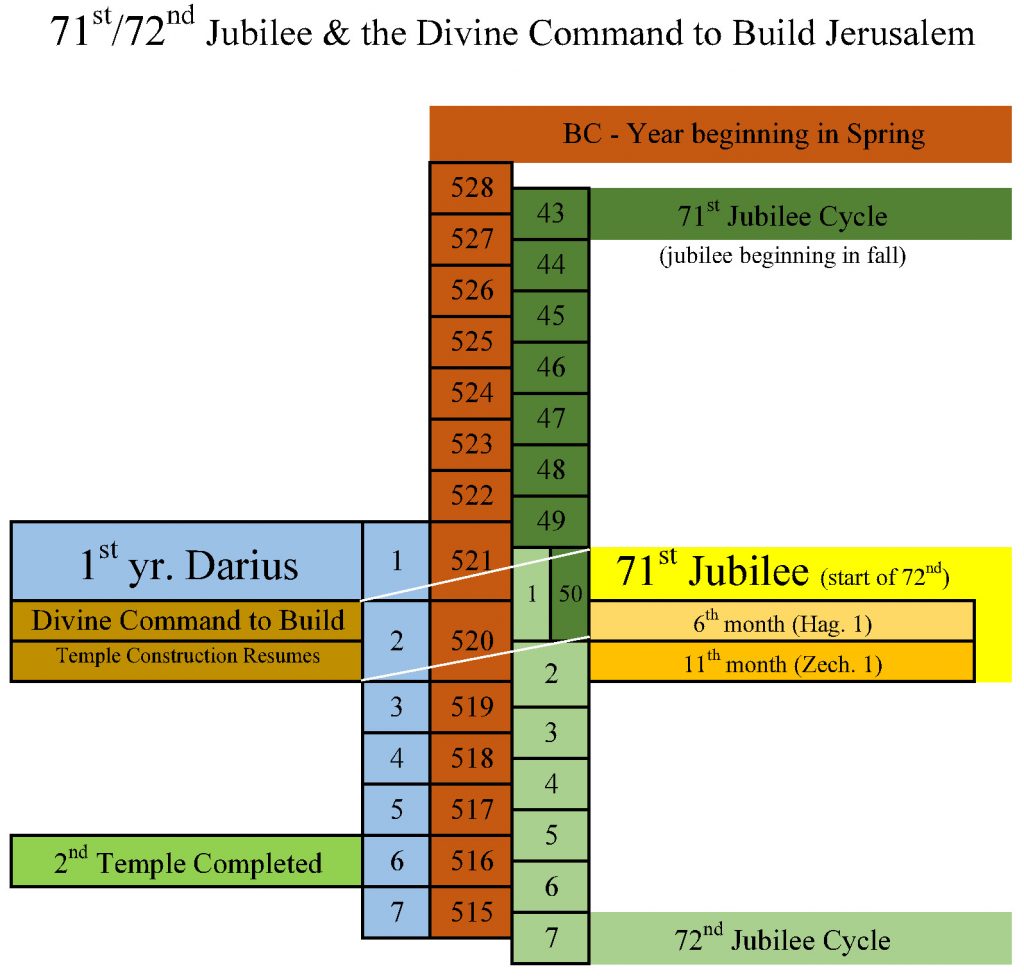
These synchronizations alone should dispel any notion that the chronology of the Masoretic text was forged. Think about the statistical difficulties of trying to make the case that the Rabbinic authorities, in order to hide the identity of Yeshua as the Biblical Messiah, dropped round numbers from the pre-flood ages of several of the descendants of Adam, and in so doing were lucky enough to still align the Jubilee cycles from Adam so that it perfectly synchronized with the Jubilee and Sabbath cycles of the 2nd temple period. And still further, that somehow even after forging this chronology, they still managed to synchronize it with the New Testament’s premier chronological account of Yeshua as the promised Messiah found in Matthew 1. If this is forgery then what does an accurate representation look like?
For those interested in further confirmation of Ezekiel’s Jubilee the following comes from the Jewish Encyclopedia and it shows that by the time the Talmud was compiled Rabbinic scholarship understood Ezekiel 40 to be a reference to a Jubilee.
Jewish Encyclopedia
Talmudic and Samaritan Calculation of Jubilees.
“According to Talmudic calculations….
….the last jubilee occurred on the “tenth day of the month [Tishri], in the fourteenth year after that the city was smitten” (Ezek. xl. 1), which was the New-Year’s Day of the jubilee (‘Ab. Zarah 9b; ‘Ar. 11b-12b). Joshua celebrated the first jubilee, and died just before the second (Seder ‘Olam R., ed. Ratner, xi. 24b-25b, xxx. 69b, Wilna, 1895).” (excerpted by WS)
To give you yet another perspective on this chronology and how it relates I’ve taken the Rabbinic world view of the three 2000 year Biblical ages as represented in the chart I shared at the start of this article. In the following chart, I’ve overlaid the MT chronology as it relates to the generations of Matthew 1, Jubilee cycles and Daniel 9.
Again, there does not appear to be any conflict between the 1st century Messianic traditions of the Jewish Talmudists and the New Testament’s representation of Yeshua as the promised Messiah. In fact, quite the contrary; there appears to be a quite startling synchronism between the traditional Rabbinic view of history and the chronological evidence we can ascertain from Masoretic text as it relates to the New Testament’s presentation of Yeshua as the Jewish Messiah found in Matthew 1 and elsewhere in the New Testament.
A Dwelling Place for Yahweh
Now let’s look at the Masoretic text chronology and the Jubilee cycles another way. Keep in mind here, we are looking for evidence which supports the hypothesis that the pre-flood chronology of the Old Testament was manipulated by the Rabbinic scholars of the 2nd century to hide the fact that Yeshua was the Bible’s promised Messiah.
In Genesis, the Garden of Eden was the location that Yahweh chose to meet with mankind. At that time, before sin entered the picture, there was no barrier between God and man. God walked in the Garden with mankind. After mankind’s sin, that relationship changed. Mankind’s sin created a barrier to our fellowship with our Creator.
Then 2513 years later, according to the MT of the Bible, a pivotal milestone was reached, Yahweh instructed Moses and the Children of Israel to construct a Tabernacle where Yahweh could dwell with mankind. This temporary dwelling place was also the location where Yahweh instituted the bloody sacrificial redemptive rites of the Torah. These sacrificial rites, as we’ve seen in these articles, were rehearsals or shadow pictures of Yeshua, Yahweh’s ultimate sacrifice, the promised “seed” through whom all nations of the earth would be blessed.
This temporary dwelling place and those sacrificial rites were instituted in the 52nd jubilee from Adam (4×13).
Nearly 500 more years pass before Yahweh gave instructions for a new more permanent dwelling place where He would meet with mankind and where the sacrificial rites of His redemptive plan would be rehearsed. This new dwelling place, constructed by David’s son Solomon, was built in Jerusalem on the same mountain where centuries earlier, Yahweh tested Abraham’s faith and asked him to sacrifice his only son in what would become one of the Bible’s most compelling symbols or allegories of Yahweh’s future redemptive plan.
This new dwelling place built by King Solomon was completed in the 62nd Jubilee from Adam.
Several more centuries pass and because of Judah’s sins they were carried away captive by Nebuchadnezzar king of Babylon. Shortly thereafter Yahweh’s Shekinah departed the first temple and then a few years after this the temple was destroyed by the armies of Nebuchadnezzar. The departure of Yahweh’s Shekinah from the temple began the 70 years of Divine anger mentioned by Zechariah. The following chart provides the pertinent details:
Then in the 2nd year of Darius ‘the Great’ Artaxerxes, Yahweh Himself, commanded Israel to return and build His house so that he could once again dwell with mankind. This commandment as I’ve shown in multiple articles at this blog and my book, Daniel’s 70 Weeks: The Keystone of Bible Prophecy was the “commandment” or word (dabar) which began the famous prophetic countdown to the Messiah found in Daniel chapter 9.
This new dwelling place was completed in the 6th year of Darius during the 72nd Jubilee from Adam.
Finally, nearly 500 more years pass and in the 82nd Jubilee from Adam (41×2) the prophesied Messiah of Daniel 9 comes and once again the terms of Yahweh’s dwelling with mankind change. Human flesh became the new dwelling place for Yahweh. Yahweh tabernacled with mankind becoming our Yeshua (Yahweh’s Salvation).
30 years later Yeshua stood in our place to take upon Himself the righteous penalty for all of our sins.
And the Word was made flesh, and dwelt [tabernacle] among us, (and we beheld his glory, the glory as of the only begotten of the Father,) full of grace and truth. (John 1:14)
These epics are visualized by the following chart:
A Divine Appointment
Multiple times over the years I’ve shared with you all how much I appreciate the story of Yahweh’s test of Abraham’s faith in asking him to sacrifice his son Isaac. That story became one of the Bible’s most illustrious allegories of Yahweh’s future redemptive plan through Yeshua.
That test of faith had divine repercussions which have rippled across the Biblical ages. This story as seen in light of the Masoretic text and the Jubilee cycles has special significance.
This allegory concealed in real Biblical history begins in the 42nd jubilee from Adam when Abraham and Sarah where told they would have a son in their old age. This message was brought to them by an angel who told them that at the “set time” in the following year a son would be born to them.
But my covenant will I establish with Isaac, which Sarah shall bear unto thee at this set time [mow’ed] in the next year. (Genesis 17:21)
For Sarah conceived, and bare Abraham a son in his old age, at the set time [mow’ed] of which God had spoken to him. (Genesis 21:2)
The phrase “set time” comes from the Hebrew word mow’ed which means appointed place or appointed time. This is the same word Yahweh uses in Genesis 1:14, when describing the Bible’s calendar, a Biblical reckoning of time, and its related divine appointments.
14 And God said, Let there be lights in the firmament of the heaven to divide the day from the night; and let them be for signs, and for seasons [mow’ed = appointements], and for days, and years: (Genesis 1:14)
In any case, this set time, or divine appointment if you will, was marked for the following year. What is intriguing about His divine appointment is that it fell on the 43rd Jubilee from Adam. In other words, exactly on the 50th year of the 43rd Jubilee cycle (from Adam) Isaac was born to Abraham and Sarah.
At some point in that 43rd Jubilee cycle, while Isaac was still a “lad” (na’ar), Abraham was told to get up to the land of Moriah and offer his son Isaac as an offering. The Bible tells us that Abraham obeyed, but he did so in the knowledge that Isaac was Yahweh’s promised seed and when all was said and done, he and the lad would return again.
And Abraham said unto his young men, Abide ye here with the ass; and I and the lad will go yonder and worship, and come again to you.
And Abraham took the wood of the burnt offering, and laid it upon Isaac his son; and he took the fire in his hand, and a knife; and they went both of them together. And Isaac spake unto Abraham his father, and said, My father: and he said, Here am I, my son. And he said, Behold the fire and the wood: but where is the lamb for a burnt offering?
And Abraham said, My son, God will provide himself a lamb for a burnt offering: so they went both of them together. (Genesis 22:5-8)
Indeed Yahweh provided that lamb in place of Isaac. In fact, it was on that very same mountain that nearly 2000 years later that Yahweh provided “Himself” as the lamb of God which taketh away the sins of the world.
Keep in mind here that because of Abraham’s faith, Yahweh swore (shaba) an oath of seven with Abraham that promised in part that through Abraham’s “seed” all nations of the earth would be blessed.
Would it surprise you to learn that according to the Masoretic text of the Bible, that oath
Yahweh swore with Abraham saw its initial fulfillment with the birth of Yeshua in the 39th (13×3) Jubilee cycles from the birth of Isaac, Abraham’s promised “seed”. In other words, the birth of Yeshua took place in the 82 Jubilee (41×2) from Adam. This 82nd Jubilee was the 39th (13×3)Jubilee from the birth of Isaac.
What’s more, on the 40th Jubilee anniversary of Isaac’s birth the last atonement sacrifice was offered in the temple in Jerusalem in 69 AD. The following year in 70 AD the temple was destroyed and now for the past 40 Jubilee cycles Israel has had neither a temple nor a sacrifice.
That chronology is summed up in the following charts: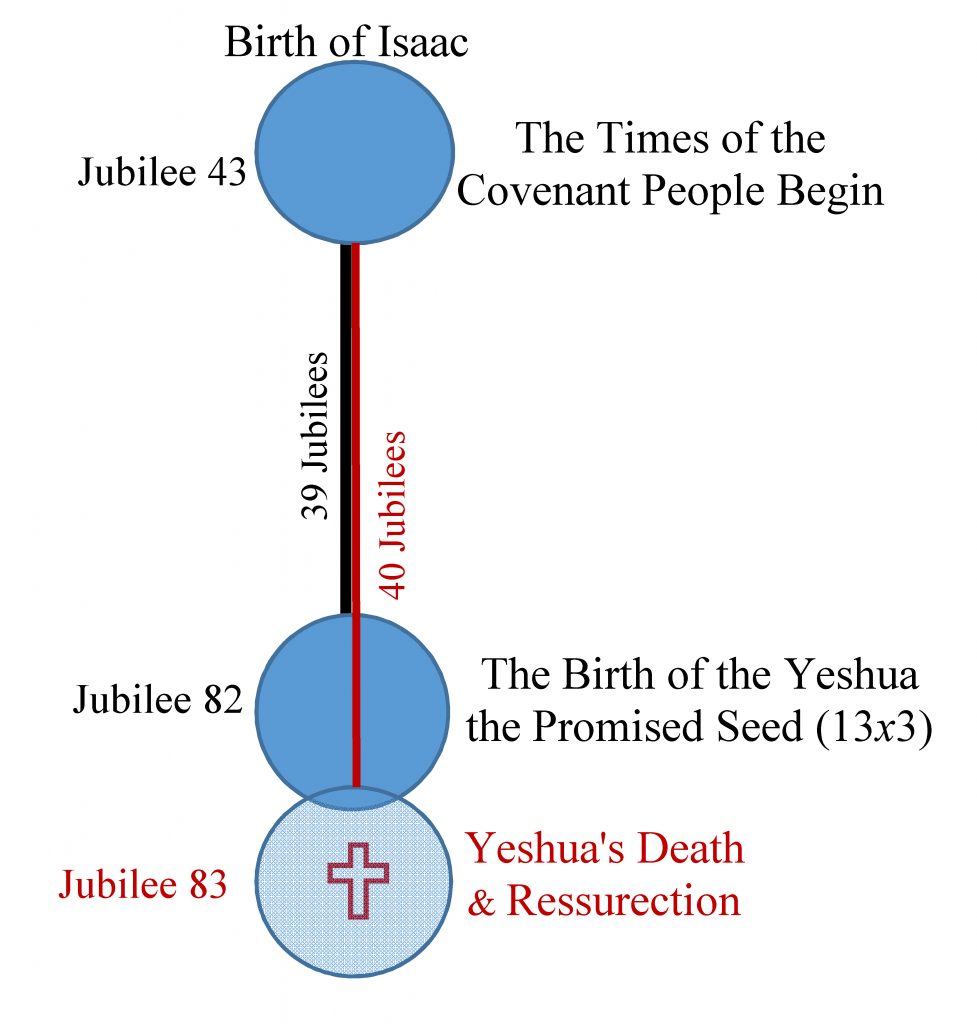
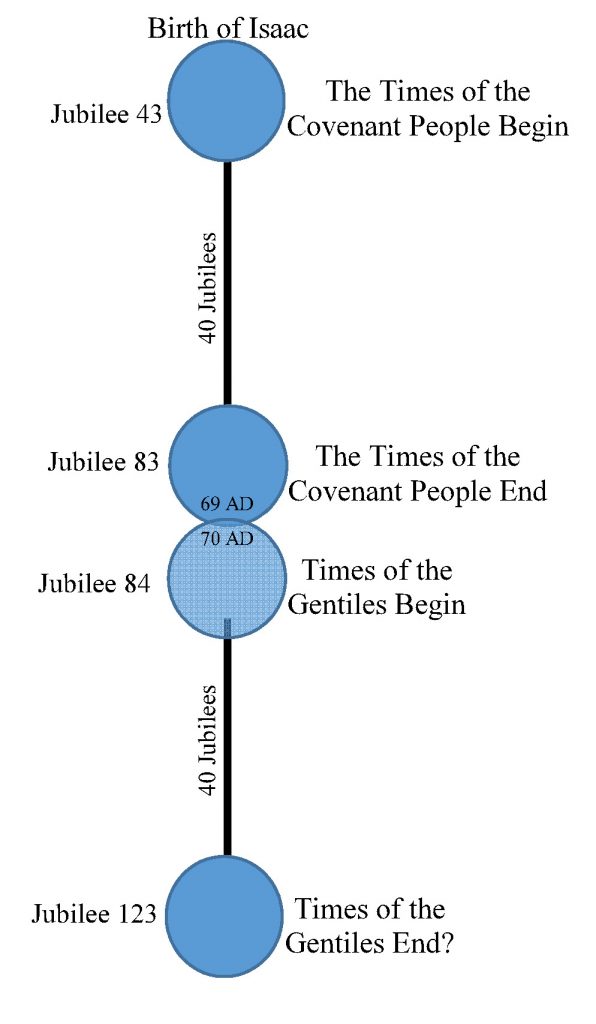
Again I wonder why, if the rabbis of the 2nd century were trying to hide the identity of Yeshua as the promised Messiah, did they align the major events in Yeshua’s life with the chronology of the Old Testament and the Jubilee cycles? A simple addition or reduction of the chronology by just a few years would have completely erased all of these synchronized chronological pictures which show Yahweh’s hand working His redemptive plan of Yeshua through the Biblical ages.
The Epics of the Promised Seed
For those familiar with Biblical history, it is evident that the number 40 is often associate with important chronological periods of time in the Bible. There are three 40 years periods which define Moses’ life and his interactions with the children of Israel. We also have the 40 years between Yeshua’s resurrection and the destruction of Jerusalem. Then there are the forty days of Jonah and the 40 days of Yeshua in the wilderness, to name just a few.
But in terms of Bible chronology, the granddaddy of 40 periods of time are the jubilee. One of the most thrilling examples of this relates to what I like to think of as the Epics of the Promised Seed.
As I’ve mentioned before, after mankind’s sin in Eden, Yahweh promised that someday Adam and Eve’s seed would bruise the serpent’s head. This promise became the foundation for the Bible’s Messianic redemptive theme.
After Cain slew Abel that promise appeared to be in jeopardy. Then in the 130th year of Adam, Seth was born and Yahweh gave Adam and Eve a new “seed” through whom that redemptive promise would be carried down through the Biblical ages. Seth’s birth not only came in the 130th year of Adam but in the 3rd Jubilee of Adam’s creation.
39 (13×3) Jubilee cycles later in the 99th year of Abraham’s life (his 2nd Jubilee) Yahweh confirmed the covenant of the promised “seed” with Abraham by promising him that at the “set time” (mow’ed) in the following year a son would be born unto them.
Neither shall thy name any more be called Abram, but thy name shall be Abraham; for a father of many nations have I made thee. And I will make thee exceeding fruitful, and I will make nations of thee, and kings shall come out of thee. And I will establish my covenant between me and thee and thy seed after thee in their generations for an everlasting covenant, to be a God unto thee, and to thy seed after thee. (Genesis 17:5-7)
That following year on the 43rd Jubilee cycle from Adam, Isaac was born. This auspicious date marked the 40th Jubilee cycle from Seth and a new era in Yahweh’s redemptive plan for mankind.
As stated previously, 39 (13×3) more Jubilee cycles pass and that covenant of the promised seed realizes its fulfillment in Yahweh becoming our Yeshua (Salvation). It was during this 39th Jubilee cycle from Isaac that an angel appeared to Mary (and later Joseph) telling them of the miraculous conception of Yeshua, the promised seed.
The following Jubilee, in the 40th Jubilee cycle from the promised seed of Isaac and the 80th Jubilee cycle from Seth, Yahweh’s promise that Adam and Eve’s “seed” would bruise the serpent’s head, finds partial fulfillment in the death and resurrection of Yeshua. I say partial fulfillment because, with this event Satan did indeed received a mortal wound, but his ultimate destruction has been set for another period of time in the future.
The above chronology leads naturally into our next example.
The Miracle of Israel’s Rebirth
For our next example of the congruency of Masoretic text chronology, the Jubilee cycles, and the Bible’s Messianic message, I’d like to show you where the miraculous rebirth of the nation of Israel fits it.
It’s important to note here that not only did Yahweh swore with Abraham that in his “seed” all nations of the earth would be blessed, but also that Abraham’s “seed” would inherit all the land Yahweh promised to Abraham.
As we saw above Israel was uprooted (for a time) from the land of Israel. With their city in ruins and Yahweh’s house completely demolished, the children of Israel were scattered throughout the nations. This desolation was prophesied by Yeshua himself in Matthew 23.
O Jerusalem, Jerusalem, thou that killest the prophets, and stonest them which are sent unto thee, how often would I have gathered thy children together, even as a hen gathereth her chickens under her wings, and ye would not! Behold, your house is left unto you desolate. 39 For I say unto you, Ye shall not see me henceforth, till ye shall say, Blessed is he that cometh in the name of the Lord. (Matthew 23:37 – 24:1)
Did you know that in the 39th Jubilee cycle (13×3) from Jerusalem’s destruction, the nation of Israel was reborn and the city of Jerusalem once more came under the control of the Jewish people? Yes, both those events (according to the projected chronology of the MT) took place in the 122nd Jubilee cycle from Adam.
Another way to look at these events is just as the 39th Jubilee cycle from Abraham saw the birth of the promised Messiah and the following Jubilee, the 40th saw the end of the sacrificial service, the destruction of Jerusalem, its temple, and the start of the times of the gentiles – the 39th Jubilee from those terrible events saw the rebirth of nation of Israel in fulfillment of Bible prophecy. And today as we watch events unfold in the 40th Jubilee from the destruction of Jerusalem we see the times of the gentiles drawing to a close and the Jewish people and the nation of Israel becoming what the book of Zechariah describes in an eschatological Messianic context, as the “burdensome stone” for the nations.
Behold, I will make Jerusalem a cup of trembling unto all the people round about, when they shall be in the siege both against Judah and against Jerusalem.
And in that day will I make Jerusalem a burdensome stone for all people: all that burden themselves with it shall be cut in pieces, though all the people of the earth be gathered together against it. (Zechariah 12:2-3)
And it shall come to pass in that day, that I will seek to destroy all the nations that come against Jerusalem. And I will pour upon the house of David, and upon the inhabitants of Jerusalem, the spirit of grace and of supplications:
and they shall look upon me whom they have pierced, and they shall mourn for him, as one mourneth for his only son, and shall be in bitterness for him, as one that is in bitterness for his firstborn.
In that day shall there be a great mourning in Jerusalem, as the mourning of Hadadrimmon in the valley of Megiddon. Zechariah 12:9-11
A Jubilee of Jubilees
For confirmation of the significance of the above chronology related to the Jewish people and their return to the land, let’s take one more step back in history to the destruction of the 1st temple by Nebuchadnezzar and Cyrus’ decree allowing the Jewish people to return to Jerusalem and build the house of Yahweh. It’s worth noting that in a Jubilee year the Torah instructs that the land reverts back to its original owners. This we see fulfilled in a unique way by looking at a Jubilee of Jubilees. The following chart provide a panoramic:
As you can see from the above chronology if you count Jubilee cycles from Cyrus’ decree allowing the Jewish people to return to Jerusalem, you’ll find that it was in the 50th Jubilee cycle from Cyrus’ decree until the Balfour Declaration (1917) and the related British Mandate (starting in 1923) allowed the Jewish people to return to their homeland.
If you also count Jubilee cycles form Yahweh’s divine “word” to restore and build Jerusalem in the 2nd year of Darius ‘the great’ Artaxerxes, you’ll find that it was during the 50th Jubilee from this divine word that Israel was reborn as a nation in 1948.
And finally in consideration of the fact that the Bible describes the new Jerusalem (a city 12×12) coming down out of heaven after the 1000 year reign of Yeshua, it is worth noting that if the Jubilee cycles were projected into the future, the 144th Jubilee cycle begins in the 8th day or 7008th year from Adam.
Design or Forgery?
In summary then, I think it is important to consider all of this Masoretic chronology and the related Jubilee cycles in light of Matthew 1. Yeshua’s lineage in this first chapter of the New Testament, as arranged by Matthew, can reasonably be considered the chronological key of the Bible’s redemptive message. This lineage is the focal point of Biblical history. We can look backwards and forwards from this amazing list of names and we find it has astounding relevance and congruency when viewed in light of Yahweh’s redemptive plan for the Jewish people and the gentile nations.
Consider once again that only four men in this lineage lived in the Jubilee cycle represented by their place in the lineage. The events and prophecies associate with each of those men are critical witnesses to the Bible’s body of evidence which proves Yeshua was the Messiah.
Each of those men, when viewed within the larger chronological context of the Bible’s chronology based in the Masoretic text, fit seamlessly into a discernable framework of Jubilee cycles originating with Adam. This in my opinion is beyond human invention.
In consideration of this evidence, it is my belief, that Matthew did indeed have knowledge of a shorter Old Testament chronology based in the Masoretic text of the Bible. It also appears evident that this knowledge also included a view of Biblical history which synchronized important events in Yahweh’s redemptive plan with the Jubilee cycles. Further, that the chronological key to Matthew’s evidence is witness by his synchronization of Yeshua’s 41 generations from Abraham with 41 Jubilee cycles which span that period of time in real Biblical chronology.
This evidence, I believe is fatal to the hypothesis that the Jewish rabbis of the 2nd century forged the Masoretic text to obfuscate the Biblical evidence that Yeshua was the Bible’s promised Messiah. In fact, I believe the contrary is evident. In light of the evidence explored in these articles, I believe a reasonable case can be made that in fact, the Old Testament chronology of the Masoretic text, was divinely ordered to provide mankind with compelling evidence that Yeshua is mankind’s promised redeemer.
Remember the former things of old: for I am God, and there is none else; I am God, and there is none like me, Declaring the end from the beginning, and from ancient times the things that are not yet done, saying, My counsel shall stand, and I will do all my pleasure:…
13 I bring near my righteousness; it shall not be far off, and my salvation shall not tarry: and I will place salvation in Zion for Israel my glory. (Isaiah 46:9-13)
Maranatha!
Next Time:
Rabbinic Forgery’s Hypothesis in Light of the 70 Weeks of Daniel 9
Yahweh willing, next time we will look at the Rabbinic forgery’s hypothesis in light of the chronology of the 2nd temple era and the prophecy of Daniel 9. As we’ll see, the indefensible irony of this hypothesis is that many who hold it, unknowingly use the chronological errors arising from it, to try and prove that Yeshua fulfilled the prophecy of Daniel 9. I hope you’ll continue this adventure with me.
Authors Note:
This article is Part III in my exploration of Rabbinic forgery hypothesis. The following links will take you to the previous articles in this series.
Part I: The Septuagint, the Masoretic Text, & Matthew 1
Part II: Matthew 1, the Masoretic Text, & the Bible’s Messianic Symbolism
Part III: The Masoretic Text, Matthew 1, & the Jubilee
Part IV: Sir Isaac Newton, Daniel 9, & the Rabbinic Forgeries Hypothesis

